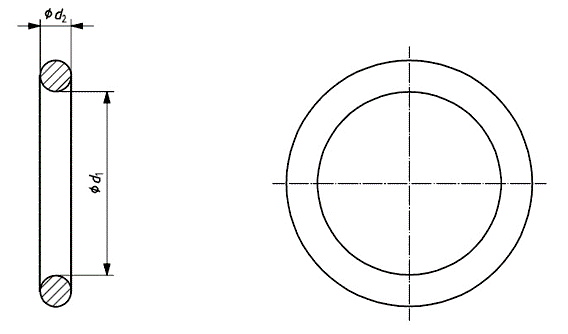Technical summary of O-rings
Dimensioning

Typical dimensions:
d1 = inner diameter
d2 = cord diameter
Rule of dimensioning: d1 x d2
Important abbreviations:
FDA – applicable in food industry (fulfillment for regulation of FDA – Food and Drug Administration)
FEP – FEP (fluoroethylene propylene) encapsulated
Coated and encapsulated O-rings
Coated O-rings are sealing elements equipped with special coatings to enhance their sealing and insulating properties. Here are some examples of coatings and their properties.PTFE (Polytetrafluoroethylene) coating
Properties: Excellent low-friction characteristics, outstanding chemical resistance, high-temperature tolerance.Example application: Hydraulic systems handling aggressive fluids.
Silicone coating
Properties: Excellent flexibility, low wear, good temperature resistance.Example application: Food industry applications where hygiene and sealing are critical.
Peroxide coating
Properties: Good chemical resistance, suitability for sterilization.Example application: Medical devices and pharmaceuticals in sterile environments.
FEP (Fluorinated Ethylene Propylene) encapsulating
It is important to distinguish that in this case we are not talking about a coating produced by layer formation. The O-ring gets a FEP tube. cover. Properties: Excellent non-adhesive characteristics, high-temperature resistance, good electrical properties.Example application: Chemical industry applications where exposure to aggressive chemicals is a concern.
Molykote coating
Properties: Excellent lubrication, low friction, wear resistance.Example application: Machinery manufacturing and automotive industry, where minimizing friction is important.
These coatings address various environmental and application requirements, improving the performance of O-rings in specific tasks. It's essential to select the appropriate coating and O-ring material for the best results in your application.
Technical guides
Application area
O-rings are widely used sealing elements employed in various industries to solve multiple sealing and insulating tasks. These rings are designed in an oval shape and are typically made of NBR, HNBR, EPDM rubber, neoprene (CR), fluoro-rubber (FKM, FPM, Viton), silicone (MVQ, VMQ), PTFE or other rubber-based materials. O-rings find applications in several areas.Hydraulics and pneumatics
O-rings are commonly used in hydraulic and pneumatic systems. They help eliminate fluid or gas leakage at connections, contributing to system efficiency and reliability.Automotive and mechanical industry
In the automotive sector, O-rings play a crucial role in engines, transmissions, and other components. They ensure the sealing of oil and other fluids, thus enhancing the efficiency of vehicles.Food industry
In the food industry, O-rings are employed in applications where sealing and hygiene are critical. They are used for handling compressed air and gases and in food processing machinery. The FDA means in product name the fulfillment for regulation of Food and Drug Administration and this products are surely applicable in food industry.Electronics
O-rings are also used in the manufacturing of electronic devices and equipment. These sealing elements help prevent dust, water, and other contaminants from entering around electronic components.Oil and gas industry
O-rings have a significant role in the oil and gas sector during drilling and transportation processes. They prevent oil and gas leakage at pipe connections and valves.O-rings offer several advantages, such as excellent wear resistance, chemical resistance, and the ability to function over a wide temperature range. Material selection is a crucial factor in meeting the specific requirements of a given application.
In conclusion, O-rings can be used to address a wide range of technical challenges, and they are indispensable in various industries for sealing and insulation purposes. It is essential to choose the appropriate material and size for the specific application to ensure reliable and efficient operation.
